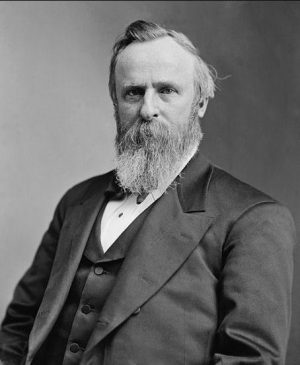Rutherford B. Hayes Death
Rutherford passed away on January 17, 1893 at the age of 70 in Fremont, Ohio USA.
When did Rutherford B. Hayes die?
January 17, 1893How old was Rutherford B. Hayes when died?
70Where did Rutherford B. Hayes die? What was the location of death?
Fremont, Ohio USA
Rutherford B. Hayes Birthday and Date of Death
Rutherford B. Hayes was born on October 4, 1822 and died on January 17, 1893. Rutherford was 70 years old at the time of death.
Birthday: October 4, 1822
Date of Death: January 17, 1893
Age at Death: 70
Is Rutherford B. Hayes's father, Rutherford Hayes Jr., dead or alive?
Rutherford Hayes Jr.'s information is not available now.
Is Rutherford B. Hayes's mother, Sophia Birchard, dead or alive?
Sophia Birchard's information is not available now.
Rutherford B. Hayes - Biography
Rutherford Birchard Hayes was the 19th President of the United States. As president, he oversaw the end of Reconstruction, began the efforts that led to civil service reform, and attempted to reconcile the divisions left over from the Civil War and Reconstruction.Hayes, an attorney in Ohio, became city solicitor of Cincinnati from 1858 to 1861. When the Civil War began, he left a fledgling political career to join the Union Army as an officer. Hayes was wounded five times, most seriously at the Battle of South Mountain; he earned a reputation for bravery in combat and was promoted to the rank of major general. After the war, he served in the U.S. Congress from 1865 to 1867 as a Republican. Hayes left Congress to run for Governor of Ohio and was elected to two consecutive terms, from 1868 to 1872, and then to a third term, from 1876 to 1877.In 1876, Hayes was elected president in one of the most contentious and confused elections in national history. He lost the popular vote to Democrat Samuel J. Tilden but he won an intensely disputed electoral college vote after a Congressional commission awarded him twenty contested electoral votes. The result was the Compromise of 1877, in which the Democrats acquiesced to Hayes's election and Hayes ended all federal army intervention in Southern politics. That caused the collapse of Republican state governments and, with Democratic disfranchisement of most blacks, first by violence and fraud, and then by law at the turn of the century, led to a one-party Democratic South into the 1960s, giving outsized power for white conservatives.Hayes believed in meritocratic government, equal treatment without regard to race, and improvement through education. He ordered federal troops to quell the Great Railroad Strike of 1877. He implemented modest civil service reforms that laid the groundwork for further reform in the 1880s and 1890s. He vetoed the Bland-Allison Act, which would have put silver money into circulation and raised prices, insisting that maintenance of the gold standard was essential to economic recovery. His policy toward Western Indians anticipated the assimilationist program of the Dawes Act of 1887.Hayes kept his pledge not to run for re-election, retired to his home in Ohio, and became an advocate of social and educational reform. His biographer Ari Hoogenboom says his greatest achievement was to restore popular faith in the presidency and to reverse the deterioration of executive power that had set in after Lincoln's death.Rutherford Birchard Hayes was born in Delaware, Ohio, on October 4, 1822, the son of Rutherford Hayes Jr. and Sophia Birchard. Hayes's father, a Vermont storekeeper, took the family to Ohio in 1817. He died ten weeks before Rutherford's birth. Sophia took charge of the family, bringing up Hayes and his sister, Fanny, the only two of the four children to survive to adulthood. She never remarried; Sophia's younger brother, Sardis Birchard, lived with the family for a time. He was always close to Hayes and became a father figure to him, contributing to his early education.Through both his father and mother, Hayes was of New England colonial ancestry. His earliest American ancestor emigrated to Connecticut from Scotland in 1625. Hayes's great-grandfather, Ezekiel Hayes, was a militia captain in Connecticut in the American Revolutionary War, but Ezekiel's son (Hayes's grandfather, also named Rutherford) left his New Haven home during the war for the relative peace of Vermont. His mother's ancestors arrived in Vermont at a similar time, and most of his close relatives outside Ohio continued to live there. John Noyes, an uncle by marriage, had been his father's business partner in Vermont and was later elected to Congress. His first cousin, Mary Jane Noyes Mead, was the mother of sculptor Larkin Goldsmith Mead and architect William Rutherford Mead. John Humphrey Noyes, the founder of the Oneida Community, was also a first cousin.








